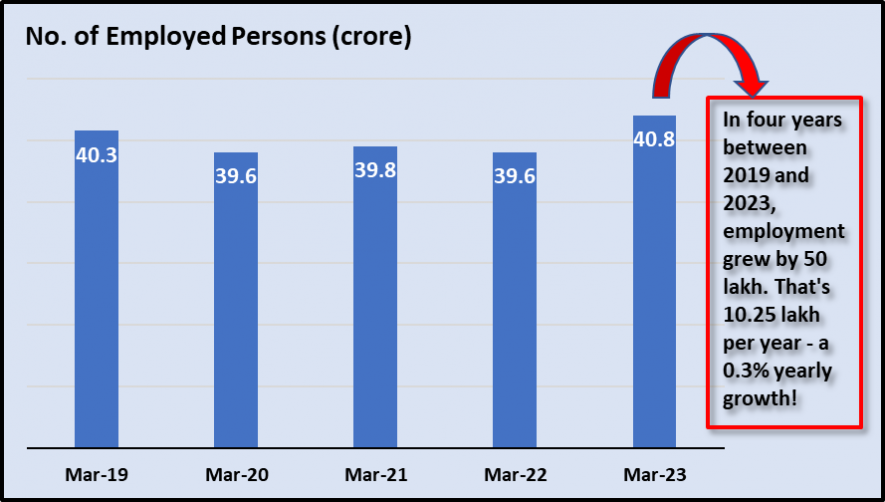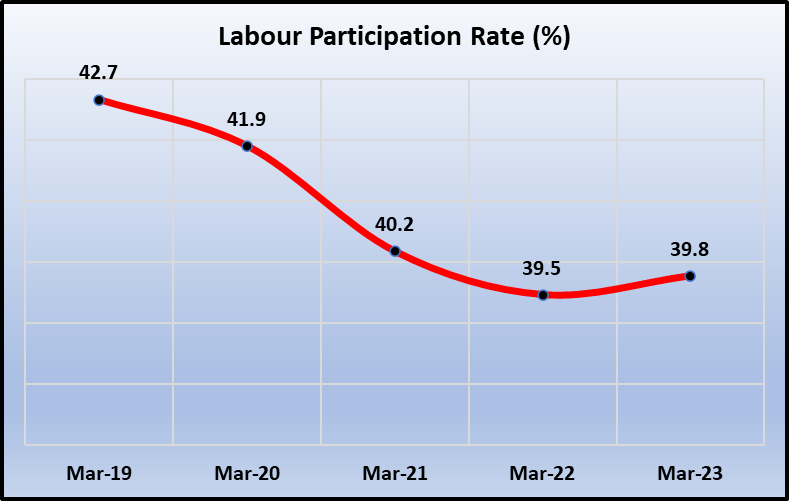No Jobs – Unless You Want Seasonal Work in Farms
For the past several years now, key economic data has become a casualty in India. There is no official data on consumption expenditure in the public domain since 2011-12 because the results of one survey (2017-18) were never released by the government, which claimed that they were flawed. A leaked report was published by media showing a fall in consumption expenditure but it was not accepted as the official version.
Employment data collection was changed from the earlier methods to a Periodic Labour Force Survey (PLFS), but this comes out with a lag and does not give all details like earlier. All this fog has paved the way for many pro-government economists moving in and painting a rosy picture of employment, poverty, inequality etc., based on partial data or even dodgy interpretations.
Recently, columnist Surjit Bhalla wrote an article in the Times of India arguing that the period 2019-22 had been one that showed the highest employment growth ever. He used PLFS data and harmonised it with Census population data to come to this rather strange conclusion. Strange, because this is the period of the pandemic and employment suffered severely in this very interval. Much of his article also criticised other data sources that are used to show that there is a dire jobs crisis in the country.
Very Low Growth in Jobs
Let us look at the data from CMIE (Centre for Monitoring Indian Economy), a private entity that provides faster data on employment, among other things. In the absence of official sources, CMIE has become the most favoured data source, especially for employment. It uses a sample just like the National Sample Survey Office (NSSO) under the ministry of statistics.
From March 2019 to March 2023, there has been a net addition of about 50 lakh jobs, according to CMIE data. (See chart below). There was, of course, a drastic fall during the first lockdown and then a slow recovery. But, unlike the celebratory interpretations that India has passed through a remarkable recovery, it is clear that the employment situation has not improved. Indeed, it seems to have worsened. Just 10.25 lakh jobs over four years works out to a new job addition of a mere 0.3% per year – which is shockingly low. It is also much, much lower than the rate at which population is growing.

The picture, however, isn’t complete unless one takes a look at the labour force participation rate (LFPR), which gives the share of persons working or seeking work in the total working age population. As shown in the chart below, LFPR has steadily declined over these four years from 42.7% in March 2019 (before the pandemic) to 39.8% in March 2023 (post-pandemic). In fact, the pandemic was more or less over last year itself, but the LFPR has inched up from 39.5% in March 2022 to only 39.8% in March 2023.

The real picture of the employment crisis is revealed by this falling LFPR. Employment growth is slow and the number of those seeking work (unemployed) is high, which ultimately leads to large sections of the working age population getting discouraged and quitting the labour force altogether. Women are more likely to do so as they in any case were doing the lowest paying and insecure jobs.
Meanwhile, the working age population has been constantly rising due to natural growth. It is estimated that about 1.2 crore people reach the working age (15 years, according to official definition) every year. Roughly, 50 lakh people would be willing to work of these, going by the current LFPR of about 40%. But far from 50 lakh per year, the country could offer only 50 lakh jobs in four years! But this is not the only problem.
Unstable Informal Work Available, Mainly on Farms
CMIE data, quoted recently by its chief, Mahesh Vyas, shows that employment in India is going through a high degree of instability and also, that agriculture has continued to be the mainstay for earning. This is best exemplified by the “churn” in employment witnessed in March 2023. In all, compared with the previous month, March 2023 saw a decline of nearly 23 lakh jobs (22.7 lakh to be precise). March usually witnesses a decline in some jobs as people shift to farms for rabi crops’ harvesting. This year’s decline is, however, substantial.
Employment in construction fell by a massive 95.8 lakh – from 7.23 crore to 6.28 crore – in March. In retail trade, employment fell from 7.58 crore in February to 6.78 crore in March, a decline of about 60 lakh.
On the other hand, employment in agriculture increased by a whopping 1.7 crore in March. According to Vyas, this is the highest increase in agriculture since CMIE started monitoring employment in 2016. Interestingly, there was large-scale movement too from activities allied with agriculture (poultry, plantations, etc) to crop cultivation. This shift was estimated at about 60 lakh.
Adding to the earlier mentioned 1.7 crore shift from other industries, farming thus saw an inflow of an incredible 2.3 crore extra hands in March. Clearly, the expected bumper harvest and the concomitant scope for better wages in harvesting or post-harvesting labour than construction or retail trade is driving this movement.
But it also shows the fragile and vulnerable nature of employment that people are getting nowadays. Low income and insecurity in other jobs and the land, call people back with some offering of security, even if it is transient.
So, to recap, here is the full picture: employment opportunities are persistently low, available jobs are low paying and with no job security, the working population constantly shifts from one job to another in search of sustenance. This is far from the Amrit Kaal or ‘achhe din’ promised by the Narendra Modi government!
Get the latest reports & analysis with people's perspective on Protests, movements & deep analytical videos, discussions of the current affairs in your Telegram app. Subscribe to NewsClick's Telegram channel & get Real-Time updates on stories, as they get published on our website.
























